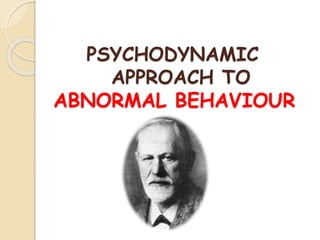
Psychodynamic paradigm of abnormal behavior
- 2. •Psychodynamics is the systematized study and theory of the psychological forces that underlie human behavior, emphasizing the interplay between unconscious and conscious motivation •The original concept of "psychodynamics" was developed by Sigmund Freud suggested that psychological processes are flows of psychological energy in a complex brain, establishing "psychodynamics" on the basis of psychological energy, which he referred to as libido.
- 3. •In general, psychodynamics studies the transformations and exchanges of “psychic energy" within the personality. A focus in psychodynamics is the connection between the energetic of emotional states in the id, ego, and superego which is also called the psychic structure They also relate to early childhood developments and processes.
- 4. •At the heart of psychological processes, according to Freud, is the ego, which he envisions as battling with three forces: the id, the super-ego, and the outside world. Hence, the basic psychodynamic model focuses on the dynamic interactions between the id, ego, and superego. Psychodynamics, subsequently, attempts to explain or interpret behavior or mental states in terms of innate emotional forces or processes
- 6. Conscious-It is that part which you are currently aware of or are actively thinking about. It consists of all the thoughts that presently occupy your mind Preconscious-The preconscious part of the psyche consists of the thoughts, memories, and knowledge that you are not currently aware of, but that are available to you. It's your storehouse of memories and knowledge.
- 7. Unconscious Is a part of our psyche that we do not have access to. It holds thoughts, memories, impulses that we are not aware of and that we cannot be aware of because they may be potentially damaging to us (i.e., cause anxiety). Even though we are not aware of the contents of our unconscious, Freud proposed that the impulses and drives within it cause much of our behavior. Freud posited that in addition to conscious, preconscious, and unconscious components of our psyche, the psyche also is composed of three structures: the id, ego, and superego. Some of these structures operate unconsciously, and others are within our awareness.
- 8. psyche 1. The Id Freud referred to the most primitive part of our psyche as the id. We are born with the id and it residues within the unconscious. The id is driven by primitive animal instincts including sexual and aggressive impulses. It functions according to the pleasure principle in that it seeks to maximize pleasure and minimize any discomfort. The id is illogical in that it seeks pleasure without thought to what is practical, safe, or moral. Freud argued that we are not aware of the id, but it influences our behavior.
- 9. 2. The Ego Freud posted that the ego is the second part of the psyche to develop. During toddlerhood, particularly during toilet training, children come to realize that they are individuals. They recognize that they have their own desires, wants, and needs; the ego forms. The ego refers to your identity, or sense of self. It grows out of the id and can control the id, to an extent. The ego functions according to the reality principle because its job is to gratify the id in accord with reality. Because the ego is concerned both with reality and the id, it operates on all three levels of awareness (the conscious, preconscious, and unconscious levels of the psyche
- 10. Super-ego The Super-ego works in contradiction to the id. The Super-ego strives to act in a socially appropriate manner, whereas the id just wants instant self-gratification. The Super-ego controls our sense of right and wrong and guilt. It helps us fit into society by getting us to act in socially acceptable ways The super-ego tends to stand in opposition to the desires of the id because of their conflicting objectives, and its aggressiveness towards the ego. The super-ego acts as the conscience, maintaining our sense of morality and proscription from taboos.
- 11. Transference neuroses correspond to a conflict between the ego and the id. narcissistic neurosesto a conflict between the ego and the superego . Psychoses is the conflict between the ego and the external world."
- 12. PSYCHOSEXUAL STAGES OF DEVELOPMENT STAGE AGE EROGENOUS ZONE GRATIFICATION Oral 0-2 years Mouth Sucking Anal 2-3 years Anal regions Retention and Elimination during toilet training. Phallic 3-5 years Genitals Self manipulation of genitals is a major source of pleasure. (Oedipus complex) Latency 6-12 years Sexual motivation recedes. Preoccupied with developing skills. Genitals After puberty Sexual relations
- 13. Freud believed that gratification during each stage is important, if a person is not to be stuck or fixated at that level. Ex-fixation at oral level may be a reason of biting fingernails or drinking. Oedipus complex— castration anxiety Electra complex — penis envy
- 14. EGO DEFENSE MECHANISMS MECHANISMS MEANING Displacement Discharging pent-up feelings to a less dangerous object. Fixation Attaching oneself in an unreasonable way to some person. Projection Attributing one’s unacceptable motives to others. Rationalization Using contrived explanations to conceal unworthy motives for one’s behaviour. Reaction Formation Adoption of seemingly opposite behaviour. Regression Retreating to an earlier developmental level Involving less mature behaviour. Repression Preventing painful or dangerous thoughts from entering consciousness. Sublimation Channeling frustrated sexual energy into substitutive activities.
- 15. Sno DISORDER PSYCHODYNAMIC VIEW 1 GAD Unconscious conflict b/w ego and id impulses. Use of defense mechanism Those with weak egos Anxiety of unresolved oedipal conflict. 2 OCD Ego’s unconscious attempt to fend off anxiety associated with hostile impulses. Ocd patients have overly harsh toilet training.—fixated in the anal sadistic stage of development. Use of defense mechanisms 3 PHOBIA Defense against the anxiety produced by repressed id impulses.Ex little hans…(freud) 4 SOMATIZATIO N Repressed emotional conflicts are converted into physical symptoms. 5 CONVERSION Repressed anxiety of unconscious drives.(ex Anna O)